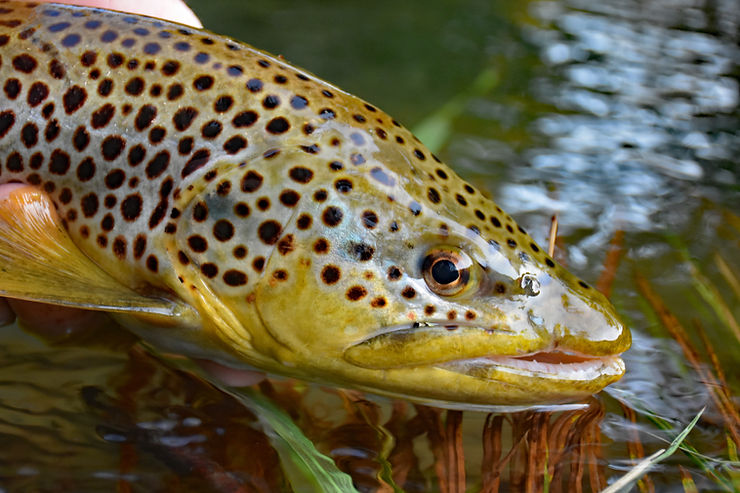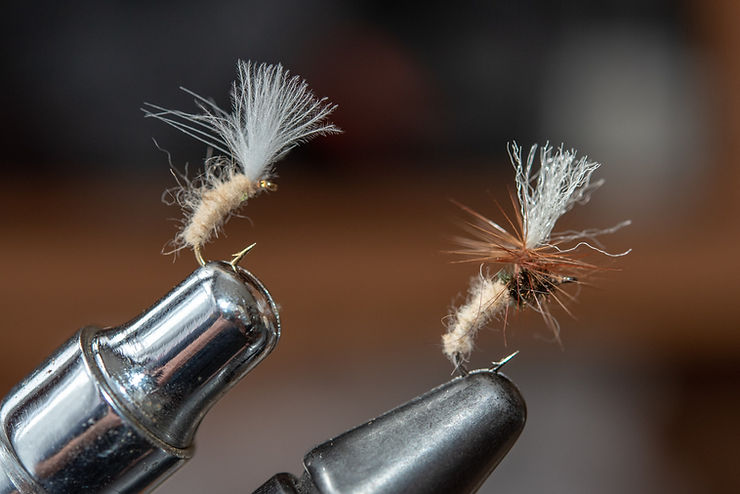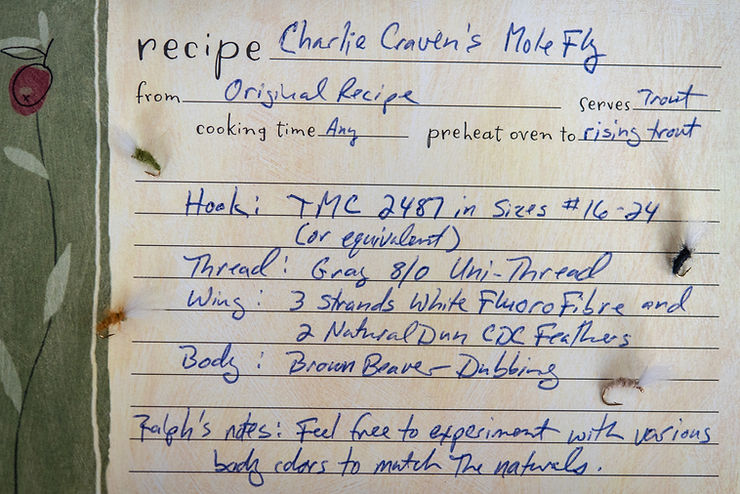Mole Fly Saves the Day: Fisherman Pleased

A few days ago, I was talking to my friend Doug Defanti about his experience on the Delaware River. The river was more crowded than usual. Big fish were a little tougher to come by. But there was one evening, he said, when he’d drawn a small audience as he landed 10 trout pretty much one after another before dark. One guy had the gumption to ask what he was using. “A Mole Fly,” Doug said.
I imagine the guy’s reaction was similar to mine. What the heck is a Mole Fly? So I looked it up.
The Mole Fly is a Charlie Craven creation. Who is Charlie Craven, you might ask? I visited his website, www.CharliesFlyBoxInc.com and read his “About Us” page. If you ask me, the guy sounds like someone I’d love to spend a day on the water with. He’s been an Umpqua Feather Merchants Signature Tyer for over 18 years and over two dozen of his own patterns are commercially available. His biography also notes that “After beating Ross Purnell in a prolonged and brutal arm wrestling match, [Charlie] became the Fly Tyer’s Bench columnist for Flyfisherman Magazine.”
And Craven’s patterns work. Some of them are complicated ties, but others are so easy even I can tie them and make them look beautiful.
The Mole Fly is a very basic pattern that can be tied using just two materials. The wing consists of CDC (Cul de Canard) bunched up and tied parallel to the hook shank with a clump of it sticking straight up over the eye of the hook. The body is dubbed. Beaver fur works well here because it’s somewhat absorbent, which allows the body to sink slightly, meaning that as the wing sticks above the surface, the body will hang straight down. Imagine a mini parachute on the water.
The key to getting the fly to float like this is the hook you use. It has to be a down-eye hook with a bend similar to that of a Klinkhamer hook. In many ways, this fly could be considered a second cousin of the Klinkhamer in design — both flies are designed to ride with wings up and abdomens hanging down into the water. Same concept except that the Mole Fly simplifies the pattern so much that it creates a whole new pattern. And the Mole Fly uses a different hook. And no hackle. And the wing positioning is somewhat different, too. (Okay, you got me, it’s nothing at all like a Klinkhamer!)

(Photo: Mole Fly on left, Klinkhamer on right. Similar features, both very effective wherever trout are found.)
I tied up a bunch of Mole flies and stashed them in my box for a rainy day. Except I didn’t have the right hook and didn’t have any Fluoro Fibre. Instead, I used a 1x-short shrimp and caddis hook, which according to the hook charts found online, appear fairly similar in design – similar enough that I hoped the trout wouldn’t notice. And since I didn’t have any Fluoro Fibre, I just skipped this material. From what I gathered watching tutorials about how to tie this pattern, these three strands are really just for added visibility and don’t have much to do with the fly’s overall effectiveness anyway.
Following Doug’s advice, I tied these flies in various colors, including cream, tan, brown, black, and gold. I tied up one of each in a size 20 and stuffed them in a small corner of my box expecting to never actually use them – which my wife would tell you is very typical of me. I’m so paranoid about not having the fly I need that I probably overcompensate with too many flies, many of which I’ll never use. In my defense, it’s good to be prepared.
(Side note: Ironically, history has proven that I am, in fact, chronically ill-prepared when it comes to practical items. In other words, I’ll never run short on fishing gear, but I may have to wear the same underwear for the whole week when we’re on vacation.)

Yesterday I was fishing a small mountain stream that is stocked but also has a strong population of wild browns. It’s just one of those holes in the wall that is known and appreciated by a handful of folks while the rest of the world goes by oblivious to this little gem.
It didn’t look like much of a gem yesterday, though. This has been an incredibly dry spring and summer, a direct contrast to the past two years of one gully-washer after another that kept the creeks borderline flood stage all season.
This stream reminded me of a series of miniature lakes connected by trickles of water. Each pool had hardly any current, although they still had depth. The surface was flat and unbroken. All of the little hiding places between the pools, such as the undercuts, pockets behind rocks, any riffles, and shaded lies under overhanging brush were all dried up. Literally, the only holding water was in the pools, and that’s where every trout in the stream was congregated.
For the first time ever, I could see exactly what was in the stream. The water was crystal clear and almost every trout was visible in each pool. If you were to drive by this stream when water levels were running normal, you’d never guess it would offer much more than a few wild browns in the 6-10-inch range, with an occasional “lunker” around 15 inches. The size of some of the trout that had been forced from their lairs was nothing short of amazing.
My second cast hooked a hard-fighting 14-inch wild brown that took a small tan caddis pupa. It wasn’t the biggest fish I’ve caught this year, but I believe it was the prettiest. Every spot and every halo looked painted on. It had the perfect amount of red lining its perfect fins. I would’ve taken a photo, but I’d left my net in the truck. So as the fish was flopping around in the water at my feet while I rummaged for my phone, it broke the line and darted off with my fly. I was using 7x tippet.
I thought it was going to be a great afternoon, but things went dead after that. Lots of trout chased flies, some snapped it up, shook their heads, and spit it out before I could set the hook. And then it got to the point where the trout lost interest completely, and if there was a group of fish, they would actually part in the middle as my line drifted through, and then reconvene after it had passed.
Toward evening, I found a pool where a few trout were sporadically rising. I couldn’t see any insects on the water or in the air. I studied the water’s surface trying to figure it out. Meanwhile, I picked up one fish on a chartreuse Mop Fly. A stocked brown which I decided to keep. I haven’t kept my limit of trout in almost four years and I’ve been craving a good fish dinner.
As the evening wore on, I was getting frustrated that all I could get were two trout. If I couldn’t get more, it was going to be a light dinner.
And then I remembered Doug’s text about using the Mole Fly: “Anytime the trotter taken something and you don’t know what, the mole fly is a great go-to fly. I’ve used it on spinner falls and hatches and anytime trout are taking emergers.” And then he sent a second text: “Trotter taken is garbled voice text for…trout are taking.”
I tied on a cream-colored Mole Fly. First cast, a brown came up nice and easy and took in the fly. I landed the fish and tossed it onto the bank with the other one. I then proceeded to catch three more stocked brown trout, completing my limit, as the evening light waned. I ended the day with seven fish, releasing two that were wild browns and keeping five stockies.
I probably could’ve caught more fish had I figured out a way to keep the Mole Fly floating better. After each catch, the fly got so saturated with water and fish slime that it sunk like a rock. But each time I got the fly dried out, a trout took it as soon as it hit the water.
I texted Doug about my day and he offered this advice: “The one problem with the Mole Fly is it’s tied with CDC. CDC floats great until it gets saturated with fish slime. That’s why I’m experimenting with tufts of snowshoe or polypro…they both float well even after catching a couple fish as long as they were treated with floatant. As for the CDC, got a couple options. One is to be prepared to change flies often, so I have a couple Mole flies all tied. The other is after catching a fish, swish it around in water to remove the slime. Then blot it with a paper towel or Amadou and re-treat it with Frog Fanny Dust. That way you can get a couple of fish out of it before it gets too saturated.”
His next text was pretty spot-on, too: “I think the fish you were catching on a cream-colored Mole were taking it for a midge. The Mole Fly is an excellent midge imitation, as well as mayfly. The fly meets all my criteria. Easy to tie, simple materials, representative of multiple species, and it catches fish.”
Did You Enjoy Reading This Article About Charlie Craven's Mole Fly Pattern?
Stay up to date with the Dark Skies Fly Fishing monthly newsletter for free and receive the latest in fly fishing news, tricks, tips, and techniques, stream reports, as well as updates on new flies added to the Online Store and exclusive discounts!
Sign Up Now
